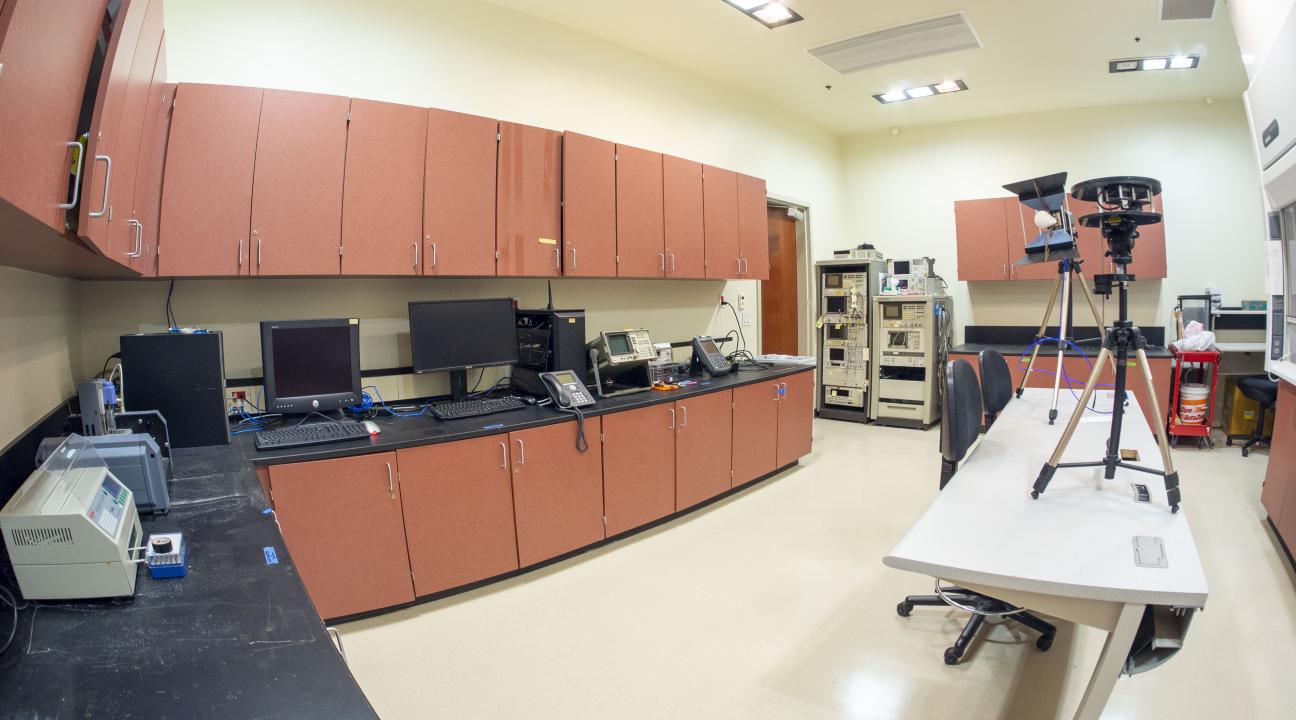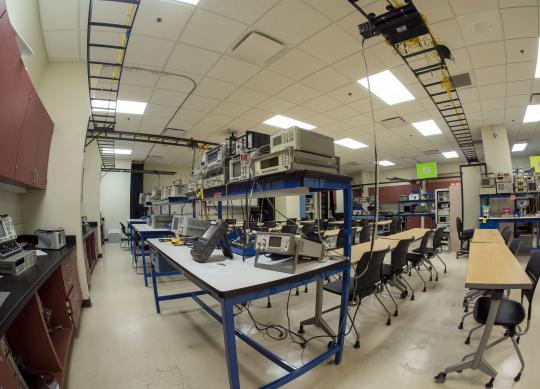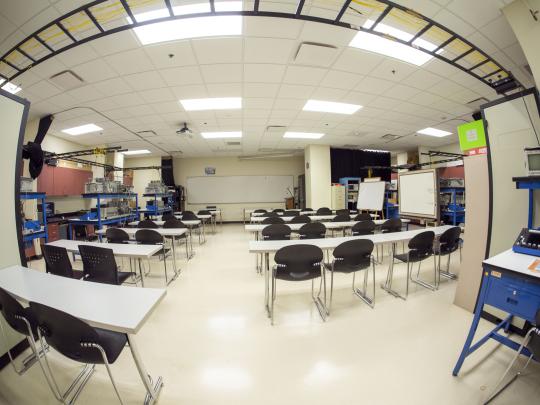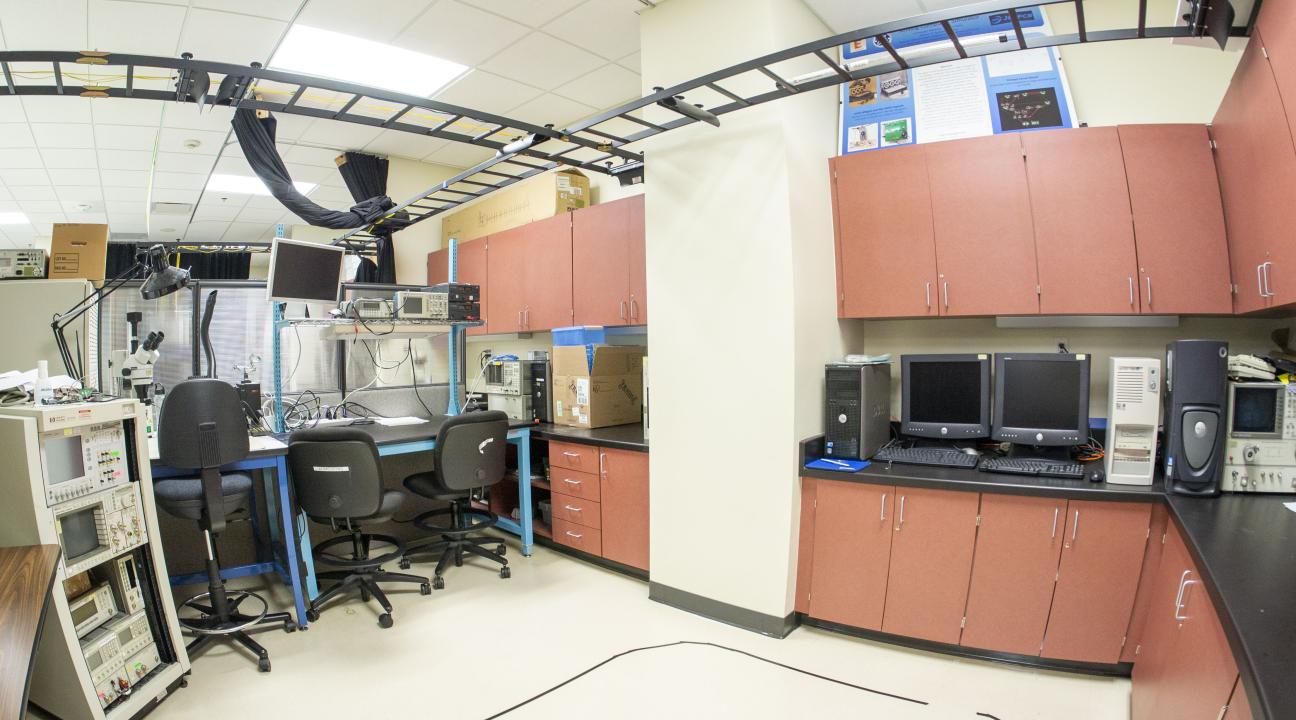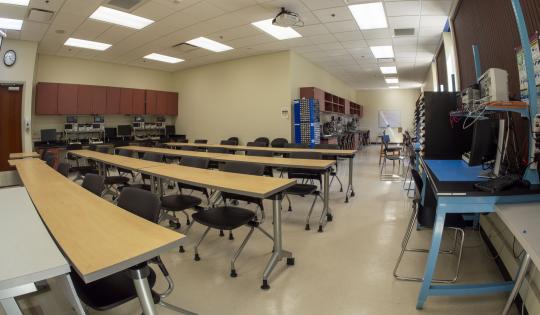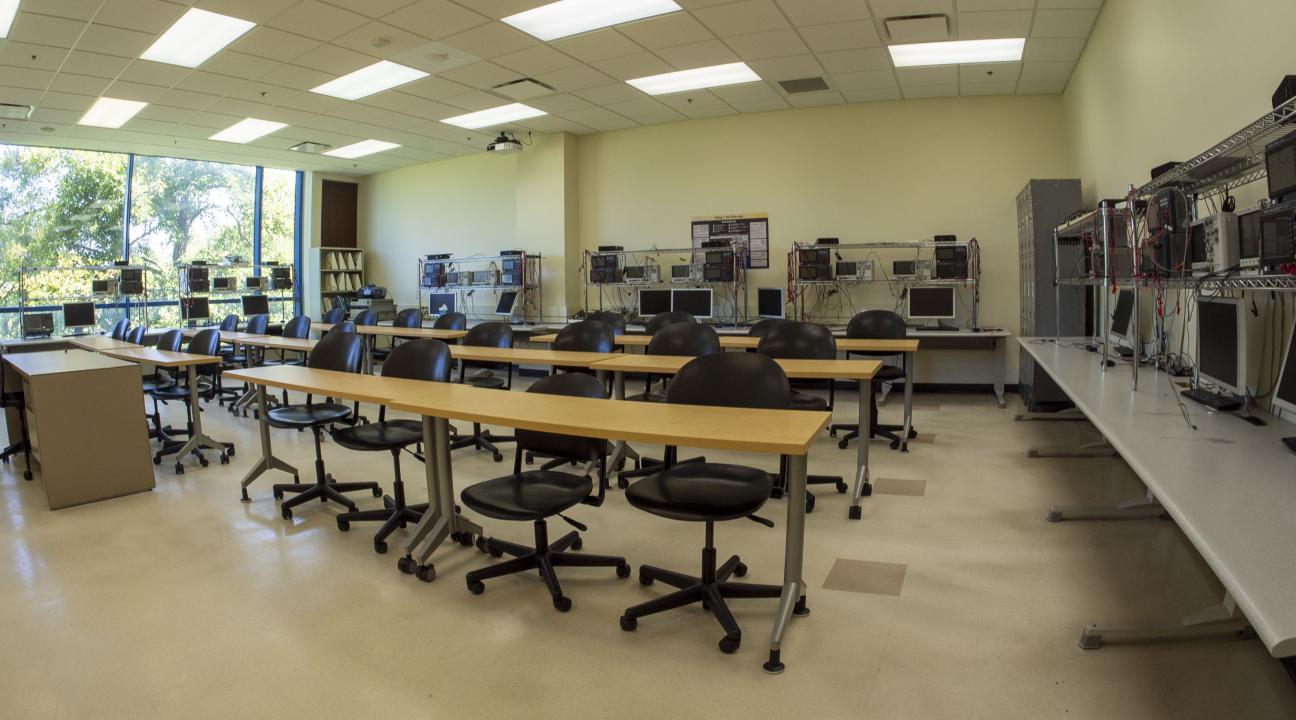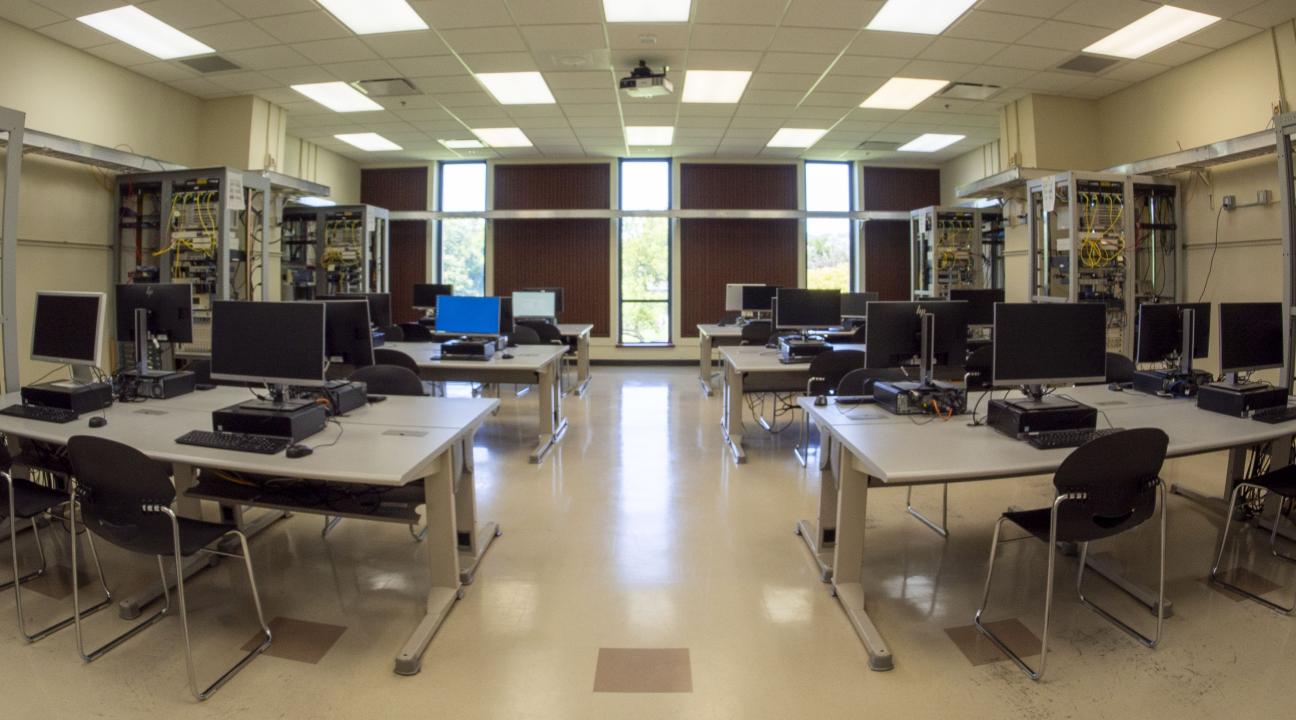Cerent Engineering Complex
The Engineering Laboratories are named as Cerent Engineering Complex to honor the engineers from 'Cerent' (now part of Cisco) whose contributions were instrumental in founding the MS-CES program (now MS-ECE). The Cerent Engineering Complex consists of eight well-equipped state-of-the-art laboratories in the areas of communications, networking, photonics, microanalysis, electronics, computer-controlled instrumentation and software engineering.
These labs are part of the Electrical Engineering and MS-ECE Programs and supported by many local industries and private funds. The goals and objectives of these labs are to (i) enrich classroom instructions with hands-on experience in the laboratories, (ii) provide cutting-edge research and development facilities to the students and faculty of SST to do state-of-the-art projects, applied research and fundamental research, and, (iii) act as incubators to develop new technology and applications. For a list of equipment in the labs, visit Equipment and Instruments in Laboratories. An overview of these labs is given below.
Research Laboratories
Advanced Internet Technology in the Interest of Society Laboratory (AITIS) (Salazar Hall 2009D)
The Advanced Internet Technology in the Interest of Society Laboratory (AITIS Lab) in the Department is dedicated to researching and developing Internet-based technology solutions for social, educational, environmental, and healthcare problems. The lab is directed by Dr. Farahmand. The research activities of this lab include Green Networking and Delay Tolerant Networking to promote universal connectivity to rural areas, as well as Internet-of-Things and its applications (see AITIS Laboratory Roadmap). The lab offers various research opportunities to both undergraduate and graduate students. Non-SSU students are welcome to discuss the possibility of working with the lab over the summer. The lab includes several soldering stations, 3-D printers, various laser sources, optical multimeters, signal analyzers, high-speed oscilloscopes, and various function generators.
Electrodynamics Engineering Laboratory (eel) (Salazar Hall 2000)
The electrodynamics engineering laboratory (eel) is established at Sonoma State Engineering Department to advance research in electromagnetic wave propagation and scattering, antenna design, novel electromagnetic materials, microwave circuit design, and real-time signal processing techniques. The lab supports a variety of undergraduate and graduate student training activities, including new curricula, workshops, summer research, and a monthly department-wide challenge (Q-MARGIN challenge), as well as mentoring SSU Mathematics Engineering Science Achievement (MESA) student members and School of Science and Technology Summer High school Internship Program (SHIP) students. The eel is directed by Dr. Mohamed Salem and is located in Salazar 2000 part of Cerent Engineering Complex. It is equipped with radio-frequency function generators, spectrum and network analyzers, standard gain horn antennas, attenuators and phase shifters, PCB milling and etching stations, a reflow oven and a SMT soldering station, and a specialized 8-core server for simulation purposes. The lab was funded partially by the School of Science and Technology start-up funds in addition to generous donations by Keysight Technologies, Inc. Members of the eel are investigating technical topics including metasurface design and fabrication, machine learning applications in electrodynamics, and the investigation of electromagnetic properties of certain local flora and fauna.
Intelligent Systems Laboratory (ISL) (Salazar Hall 2002)

The mission of the Intelligent Systems Lab (ISL) at Sonoma State University is to advance research and teaching in smart and intelligent systems as applied in biomedical sensing, embedded systems, computer vision, and robotics. We solve engineering problems through the design, development, test, and verification of hardware and software. Located in Salazar Hall #2002, the lab is equipped with oscilloscopes, function generators, power sources, digital multimeters, and a soldering station. There are four computers and two benchtop working areas. The computers in the lab have a range of software for engineering design, modeling, and testing. The lab has two five-axis robotic arms, one mobile robot, graphical processing unit boards, Radar boards, microcontrollers, and many parts and supplies. A controlled sensor array test setup is located in a fume hood in Salazar Hall #200. Thus far, the lab has served 28 students through various research projects. It has also been used for demonstrations and tours for numerous Engineering outreach events. The lab has been supported by the SSU start-up fund, Koret awards, SSU Office of Research and Sponsored Program (ORSP) grants, SSU School of Science and Technology (SST) dean’s office, and the SSU Engineering department. The lab currently supports five undergraduate and six graduate students through five ongoing research projects. It also supports three additional students through two senior design projects.
Instructional Laboratories
AFC Electronics Lab - 2 (Salazar Hall 2005)
Named after the industry Advanced Fibre Communications (now part of Tellabs), one of the Program's major supporters, this lab is dedicated to teaching digital and analog communications and advanced electronics. The lab has 12 stations, each having a mixed-signal oscilloscope with built-in function generator, a bench-top multimeter, a proto-board, a triple-output power supply and a PC. Students share the existing network and spectrum analyzers when needed. This laboratory also accommodates Digital Circuit & Logic Design lecture and Laboratory (EE210).
Agilent Technologies R&D Lab (Salazar Hall 2002)
Named after the industry's Agilent Technologies, one of the Program's major supporters, this laboratory is equipped with state-of-the-art optical communications equipment such as optical switches, optical spectrum analyzers, BERT systems, high frequency signal sources, digital communications analyzers, optical transmitters and receivers. The lab is capable of emulating various configurations of optical fiber communications systems, studying optical networking, analyzing and evaluating their performances.
Rolf Illsley Optical & RF Communications Lab (Salazar Hall 2001)
Named after the founder of Optical Coating Laboratory, Inc. (OCLI), a major supporter of the MS-CES Program and a division of JDS Uniphase, this laboratory is equipped with state-of-the-art photonics equipment. It is organized in six experimental stations each with equipment such as optical spectrum analyzers, optical power meters, sweep wavelength system receivers, microscopes, etc. Other major equipment in the lab are various types of light sources, splicing stations, 48-port AWG devices, a variety of couplers, connectors, etc. Students in photonics and optical fiber communications courses can characterize lightwave components and devices and optical fibers, and study beam propagation behavior.
In addition, the laboratory is equipped with the optical and telecommunication software modeling tools from RSoft. This allows the students to simulate their experiments and compare the two results.
W. M. Keck Microanalysis, Robotics Exploration, Sensing & System Engineering Lab (Salazar Hall 2009B)
The Microanalysis Laboratory consists of four major instruments at the present time:
- Hitachi Scanning Electron Microscope (SEM) (Salazar Hall 2009C)
The SEM instrument is configured to allow imaging of inorganic objects as well as the more difficult to prepare and analyze biological specimens. Magnification up to 300,000X is well within the range of the instrument. A sample holder allows us to maintain the sample temperature from -20C to +85C. In addition, to the traditional SEM functionality, this instrument is equipped with Energy Dispersive X-ray Analysis (EDX). We are able to collect full atomic elemental analysis on a per pixel basis of the entire SEM image. As such we obtain extremely magnified images while simultaneously measuring the elemental content of any portion of the image. - Olympus confocal imaging system (Salazar Hall 2009D)
The confocal imaging facility is equipped with an Olympus FV300 laser scanning system attached to an Olympus BX61 upright microscope. This system has three lasers: Argon (488 nm), Red HeNe (633 nm) and Green HeNe (543 nm) allowing the utilization of a wide range of fluorescent probes for specimen analysis. The unique feature of this instrument is its ability to generate 3D confocal images of a variety of living and non-living biological materials. With the help of an SIS Biological Suite Imaging Software, the digital camera attached to the above microscope system allows researchers to gather and analyze high quality bright-field, dark-field, phase and Nomarski-DIC images of specimens. - Pacific Nanotechnology Scanning Probe Microscope (SPM)(Salazar Hall 2009B)
The Pacific Nanotechnology SPM is a tool that allows us to measure the properties of atomic surfaces. Sometimes the SPM is referred to as an Atomic Force Microscope (AFM). The SPM or AFM is comprised of a very small and sharp tip, the point of which is only a few atoms in diameters. This tip is connected to a cantilever and is moved in a systematic way over the surface of the sample. The repulsive Van der Waals force between the tip and the sample results in the movement of the cantilever. That movement is imaged via a secondary laser system built into the instrument. Typical scan areas can vary from 100 nanometers(nm) X 100 nanometers up to 100 microns X 100 microns. A nanometer is 10-9 meters, while a micron is 10-6 meters. The height profile ranges from 0.1 nm to 100 nm. An instrument similar to this instrument recently certified the average roughness of the mirrors used in the new NASA x-ray telescope EXAFS.
Each of the above instrument probes a different aspect of a particular sample. Therefore, the combination of these instruments is actually more important than any one instrument. In combination, we can learn/deduce key mechanism in the formation of the sample. For example, we can determine whether a thin film was evaporated or sputter deposited. We can deduce the ability of a thin film sample to withstand abrasion and predict how well it will withstand harsh chemical environments.
Networking Laboratory (Salazar Hall 2006)
This laboratory provides facilities for instruction and experimentation in computer networking. There are six identically equipped work areas containing hubs, switches, routers and computers that can be connected and configured for a wide range of networking experiments, such as LAN, VLAN and WAN designs. Every computer can run a choice of operating systems, either Windows or Ubuntu, and each contains a variety of programming and networking tools for network analysis. There are easily reconfigured interconnections that connect the work areas to each other, to dedicated servers and to the Internet.
Capstone Project Lab (Salazar Hall 2007)
The facilities in this laboratory support undergraduate engineering students in order to complete their capstone senior design experiments. Students enrolled in the Senior Design Project Planning/Implementation (EE492/493) have 24/7 access to the lab. A wide range of hardware and software development tools are available upon request to the students in this laboratory, including high-speed oscilloscopes, logic analyzers, function generators, pattern generators, power supplies, digital multimeters, spectrum analyzers, network analyzers, signal generators, wireless testing instruments, STE series Shielded Test Enclosures, and more. All workstation PCs in the lab are equipped with various software including Keysight Software Suite, Mathworks Matlab and NI Labview and Multisim, Solidworks, Microchip MPLAB, MS Office Professional, Python and MS Visual Studio. In addition to the above items, the room has a small refrigerator, microwave and a kettle for highly motivated students!
Human-Computer & Robotics Lab (Salazar Hall 2008)
This laboratory provides computers and software that support a range of software projects as well as undergraduate and graduate instruction in software engineering. For each computer there is a choice of standard operating systems and a selection of software including compilers, databases, and tools for graphics. The lab is configured to be used either for projects or for classroom instruction. One computer is connected to a large screen data projector and wireless keyboard and mouse for convenient instruction. All computers are networked to the Internet.
Electronics Lab - I (Salazar Hall 2003)
The electronics laboratory is equipped with function generators, oscilloscopes, logic analyzers, multimeters, power supplies, networked computers, soldering stations and necessary breadboards and electronic components. In addition, it is equipped with Cadence, Keysight, Matlab and NI software packages.
The lab is used to provide fundamental as well as advanced instruction to undergraduate and graduate students in digital and analog electronics, VLSI design, embedded systems and computer architecture. In addition, students use these facilities to carry out their design projects and research.
SSU Makerspace
This facility is not part of Cerent Engineering Science Complex but is available to all students. The SSU Makerspace is a place to dream, make, and innovate. SSU students, faculty, and staff are invited to explore digital fabrication, prototyping, and a wide range of technology to transform idea to reality. All disciplines and skill sets can experience new technologies through workshops, experimentation, and free-play. By providing the tools and ingredients the hope is to encourage creativity and inquiry, and to facilitate cross-disciplinary collaboration.





